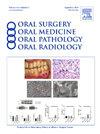Role of the programmed death-ligand 1 (PD-L1) and antigen-presenting natural killer (AP-NK) cells in immunosuppressive tumor microenvironment (TME) of oral squamous cell carcinomas
IF 1.9
3区 医学
Q2 DENTISTRY, ORAL SURGERY & MEDICINE
Oral Surgery Oral Medicine Oral Pathology Oral Radiology
Pub Date : 2025-07-21
DOI:10.1016/j.oooo.2025.04.064
引用次数: 0
Abstract
Immune checkpoint blockade (ICB) response rate targeting PD-1/PD-L1 in oral squamous cell carcinomas (OSCC) is lower (< 20%) than other solid cancers. Identifying factors contributing to an immunosuppressive TME may inform cancer progression. AP-NK cells co-expressing CD8αα and HLA-DR antigens promote immunosuppression by selectively killing effector T-cells.
Methods: Tissue microarray of OSCC (n = 64), oral epithelial dysplasia (OED, n = 14), proliferative verrucous leukoplakia which progressed to OSCC (PVL; n = 6), and oral lichen planus (OLP; n = 5) were used in this study. By immunohistochemistry (IHC), we evaluated PD-L1 expression (Clone 22C3) in tumor cells by the Tumor Proportion Score (TPS) and in tumor infiltrating lymphocytes (TIL). IHC for CD3, CD8, and CD8 and HLA-DR double labeling was used for phenotyping the TIL. We used Fisher’s exact test to compare categorical variables and Student’s t test for continuous variables.
Results
PD-L1 expression in TIL (negative: 0%-5%; positive > 5%) showed significant correlation with tumor site, nodal status, and survival. OSCC were classified into four TME types based on their TPS and the number of CD3-positive TIL. (1) PD-L1 negative (TPS <5%) and scant CD3+TIL in 39% (2) PD-L1 negative (TPS <5%) and high CD3+TIL in 34% (3) PD-L1 positive (TPS >5%) and a high CD3+TIL (ICB responders) in 14% (4) PD-L1 positive (TPS > 5%) and scant CD3+TIL in 13%. CD3+ve T-cells were significantly lower (P = .0075) in OED and PVL compared to OLP. There was a trend for increased AP-NK cells and % of AP-NK/CD3 cells in OED (56.7±10.1; 2%) and PVL (64.5 ± 24.2; 7%) compared to OLP (30.5±7.4; 0.7%). There was no statistically significant correlation between TPS and age, gender, smoking status, tumor site, histology grade, tumor stage, nodal status, survival, and TIL density.
Conclusion
In addition to PD1/PD-L1 pathway, our data supports AP-NK cells playing a role in promoting immunosuppressive TME in OSSC.
程序性死亡配体1 (PD-L1)和抗原呈递自然杀伤细胞(AP-NK)在口腔鳞状细胞癌免疫抑制性肿瘤微环境(TME)中的作用
针对PD-1/PD-L1的免疫检查点阻断(ICB)在口腔鳞状细胞癌(OSCC)中的应答率较低(<;20%),高于其他实体癌。确定导致免疫抑制性TME的因素可能会告知癌症的进展。AP-NK细胞共表达CD8αα和HLA-DR抗原,通过选择性杀伤效应t细胞促进免疫抑制。方法:组织芯片检测OSCC (n = 64)、口腔上皮发育不良(n = 14)、进展为OSCC (PVL)的增殖性疣状白斑;n = 6),口腔扁平苔藓(OLP;N = 5)。采用免疫组化(IHC)方法,通过肿瘤比例评分(TPS)和肿瘤浸润淋巴细胞(TIL)评估PD-L1(克隆22C3)在肿瘤细胞中的表达。免疫组化CD3、CD8、CD8和HLA-DR双标记用于TIL表型分析。我们使用Fisher精确检验来比较分类变量和学生t检验来比较连续变量。结果TIL中spd - l1表达(阴性:0% ~ 5%;积极的在5%)与肿瘤部位、淋巴结状态及生存率有显著相关性。根据TPS和cd3阳性TIL的数量将OSCC分为4种TME类型。(1) PD-L1阴性(TPS <5%)和低CD3+TIL占39% (2)PD-L1阴性(TPS <5%)和高CD3+TIL占34% (3)PD-L1阳性(TPS <5%)和高CD3+TIL (ICB应答者)占14% (4)PD-L1阳性(TPS <;5%)和缺乏CD3+TIL(13%)。与OLP相比,OED和PVL的CD3+ve t细胞明显降低(P = .0075)。OED中AP-NK细胞和AP-NK/CD3细胞百分比均有增加的趋势(56.7±10.1;PVL(64.5±24.2;7%)与OLP(30.5±7.4;0.7%)。TPS与年龄、性别、吸烟状况、肿瘤部位、组织学分级、肿瘤分期、淋巴结状态、生存率、TIL密度无统计学意义。结论除PD1/PD-L1通路外,我们的数据支持AP-NK细胞在OSSC中促进免疫抑制性TME的作用。
本文章由计算机程序翻译,如有差异,请以英文原文为准。
求助全文
约1分钟内获得全文
求助全文
来源期刊

Oral Surgery Oral Medicine Oral Pathology Oral Radiology
DENTISTRY, ORAL SURGERY & MEDICINE-
CiteScore
3.80
自引率
6.90%
发文量
1217
审稿时长
2-4 weeks
期刊介绍:
Oral Surgery, Oral Medicine, Oral Pathology and Oral Radiology is required reading for anyone in the fields of oral surgery, oral medicine, oral pathology, oral radiology or advanced general practice dentistry. It is the only major dental journal that provides a practical and complete overview of the medical and surgical techniques of dental practice in four areas. Topics covered include such current issues as dental implants, treatment of HIV-infected patients, and evaluation and treatment of TMJ disorders. The official publication for nine societies, the Journal is recommended for initial purchase in the Brandon Hill study, Selected List of Books and Journals for the Small Medical Library.
 求助内容:
求助内容: 应助结果提醒方式:
应助结果提醒方式:


